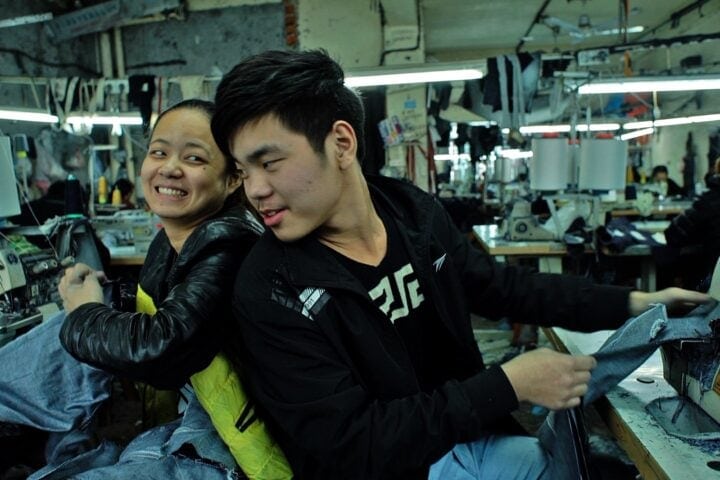Wang Bing made his directorial debut with an astonishing odyssey through the dilapidated structures of the danwei, or state-owned factory, that were the norm for work in China until opening and reform gradually gave rise to more private enterprise. The 551-minute 2002 film, Tie Xi Qu: West of the Tracks, telegraphed its intentionality both through its politics, starkly depicting the lives of factory workers and the strain put on Shenyang’s industrial Tiexi district, as joblessness loomed. The film’s intuitive, necessarily lo-fi aesthetic allowed the artifacting visuals of its DV shooting format to become a conduit through which to further imagine the fate of the eroding spaces of the danwei.
The monumental achievement of West of the Tracks galvanized the field of Chinese independent documentary in the early 2000s to such a degree that a new generation of filmmakers seemed to form almost instantly and take specific cues from Wang’s DIY ethos. But Wang hasn’t stayed the trail-blazing course, as his subsequent films haven’t been as radical in form nor quite as immediately provocative in their politics.
Instead, the most significant project to come out of Wang’s career in the more than two decades since his debut has been a commitment to oral histories, in particular exhaustive testimonials from survivors of Mao’s Anti-Rightist campaign in the 1950s. In 2007’s 184-minute Fengming: A Chinese Memoir and the 2018 diptych of Dead Souls (495 minutes) and Beauty Lives in Freedom (330 minutes), Wang wields probably the most characteristic facet of his cinema: his attention-testing emphasis on duration. He applies it to a procession of medium shots and close-ups of his subjects in those films as a means of “recording” the voluminous recollections of individuals who lived through one of the most fraught periods of modern Chinese history.
Wang’s latest release, the 212-minute Youth (Spring), is itself part of a much larger project: It was shot between 2014 and 2019 and is the first in a three-film series that will follow the same collection of largely but not exclusively young migrant textile workers (the “youth” part of the film’s name actually comes from its French translation, while “spring” is the direct meaning of its Chinese title). Youth (Spring) was shot largely in the tier-three Chinese city of Huzhou and was made concurrently with both Wang’s 157-minute Bitter Money, released way back in 2016, and his 2017 museum installation 15 Hours, which is indeed as long as the title says.
All of these languorously observe the act of labor in textile factories, and taking those earlier films into account balloons the total runtime of this project way past the 10-hour estimation that Wang gave for his planned trilogy in a recent Cahiers du Cinema interview. In fact, it doesn’t seem in any way a stretch to say that, when it’s all said and done, Wang should easily be in contention for the most released footage devoted to one specific subject in film history.
Within its broader matrix of documentary works, Youth (Spring) is notable mainly for its comparative accessibility. Whereas 15 Hours seems very much designed to be absorbed in sections in a gallery setting, and the underrated Bitter Money (which largely flew under the radar of even Wang Bing enthusiasts) scanned as a bleaker, angrier portrait of capitalist exploitation, this particular immersion in the social culture of textile laborers projects mainly a sense of buoyancy and curiosity. And this impression of Youth (Spring) allows for both its modest successes and more specious implications.
The most intriguing aesthetic feature of Youth (Spring) is its often-present diegetic soundtrack: An assortment of Mando-pop songs play over tinny speakers as Wang’s subjects engage in both synchronized and syncopated labor, their choreographed hands dancing around sewing machine needles. During these sequences, and without any overt aestheticization, the film sometimes takes on the feel of a movie musical. There’s a tension at work here between mechanical, collective labor and the expression of individualism, which seems continually catalyzed by the musical accompaniment—not only in that it causes workers to break their stoical facades to sing along, but also because the music’s romantic narratives seem to spur the little flirtations and courtships that unfold in front of us on the factory floor.
That clever and evocative juxtaposition, though, doesn’t require Wang’s customary three-hour-plus runtime to be effective. Repetition here simply doesn’t serve as the same conceptual ballast that it has been for many of Wang’s best films; rather, duration this time feels like a transparently calculated bid for arthouse austerity. Compare whatever reasoning one could muster for the bloated runtime of this film to that behind Wang’s oral history documentaries: In the case of elders like Fengming or artist Gao Ertai (the subject of Beauty Lives in Freedom), it’s both the wealth of experiences that they lived through and the deprivation of resources they’ve had available to them throughout their lives to record those experiences that made Wang’s documentation of their narratives a necessary and vital act of archival activism.
In contrast, the individuals of Youth (Spring) have no real shortage of ways to perpetually document their own realities. We see those means throughout the film, whether it’s the cellphones they’re glued to just as much as youths in this country or the computer cafes they patronize on rare days off. Need further proof of young factory workers’ propensity to document themselves? Skim through the news and find stories about the videos from Covid-era protests cropping up all over TikTok. The impulse to merely and exhaustively document an unremitting social reality in China without any broader aesthetic goals isn’t justification enough anymore.
Insomuch as there’s an effort to expand the narratological depth of Youth (Spring), that process proceeds about as one would expect for a film largely funded by European financiers and selected for many festivals without being subjected to the resistance that’s greeted many Chinese films in the international market in recent years. Amid the hardships of factory life, there are glimmers of hope found in blossoming relationships or through the successful, collective efforts to convince factory bosses to raise wages. That’s a political softness that tends to come off particularly galling considering the economic realities actually facing youth in China right now: The record-high numbers of unemployment for young people that have been met with such concern that Xi Jinping’s decided to suspend release of such reports until further notice.
Around the turn of the millennium, Chinese documentaries keyed to an observational mode often served as essential incubators for provocative sociopolitical ideas—with filmmakers like Wang, Zhao Liang (Behemoth), and Xu Xin (A Yangtze Landscape) directly challenging state-sanctioned narratives of representation. What Youth (Spring) tends to enforce is the impression that Xi Jinping’s limits of control have largely eliminated the possibility for documentaries in that old mold (such as it even still exists) to have any influential impact on a global stage.
Whether Wang is a willing adopter of the political status-quoism represented by his new film or has merely accepted that which he cannot change, the resulting work—while not without flashes of the aesthetic sensibility and the acute social observation that have made him an accomplished documentarian—feels underdeveloped by his standards. Twenty years on from Tie Xi Qu: West of the Tracks, we return with Wang to the factory floor, but this time he doesn’t muster the formal strategies or the narratological scope that once allowed him (and us) to imagine broader implications for China’s future. In Youth (Spring), duration only signifies stasis.
Since 2001, we've brought you uncompromising, candid takes on the world of film, music, television, video games, theater, and more. Independently owned and operated publications like Slant have been hit hard in recent years, but we’re committed to keeping our content free and accessible—meaning no paywalls or fees.
If you like what we do, please consider subscribing to our Patreon or making a donation.





